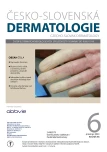Raynaud’s Phenomenon
Authors:
D. Karetová; A. Jeníšová
Authors‘ workplace:
II. interní klinika kardiologie a angiologie 1. LF UK a VFN, Praha
Published in:
Čes-slov Derm, 98, 2023, No. 6, p. 279-287
Category:
Reviews (Continuing Medical Education)
Overview
Raynaud’s phenomenon (RF) is a disease based on paroxysmal vasospasm of peripheral arterioles, which leads to tissue hypoperfusion. It most often arises on the basis of cold or emotionally stressful stimulus. It is accompanied by significant pain and possible limitation of the function of the affected part of the body.Primary RF is characterized by an increased tendency to vasospasm on the basis of higher sympathetictone, affects otherwise healthy younger individuals, and the disease can spontaneously disappear. In thecase of secondary RF, the basis is another, often systemic, disease (most often systemic scleroderma andrelated diseases), the manifestations are more severe and can lead, on the basis of induced morphologicalchanges, to ulceration. The basis of diagnosis is a typical clinical picture; evidence of autoantibodies and abnormal capillaroscopic findings are evidence for the secondary form. Treatment consists of regimen measures, psychotherapy, or the administration of vasodilators from various drug groups. Significantly symptomatic individuals are treated with prostanoid infusions or sympathectomy.
Keywords:
Raynaud’s phenomenon – primary Raynaud’s phenomenon – secondary Raynaud’s phenomenon – vasodilatation – sympathectomy
Sources
- ABOU-RAYA, A., ABOU-RAYA, S., HELMII, M. Statins: potentially useful in therapy of systemic sclerosis-related Raynaud´s phenomenon and digital ulcers. JRheumatol., 2008, 35, p. 1801–1808.
- BELCH, J., CARLIZZA, A., CARPENTIER, P. H. et al. ESVM guidelines – the diagnosis and management of Raynaud‘s phenomenon. Vasa, 2017, 46(6), p. 413–423. doi: 10.1024/0301-1526/a000661. Epub 2017 Sep 12. PMID: 28895508.
- BRHEL, P. Raynaudův syndrom způsobený prací s vibrujícími nástroji. Interní medicína pro praxi, 2007, 9(10), p. 444–447.
- CAGLAYAN, E., HUNTGEBURTH, M., KARASCH, T. et al. Phosphodiesterase type 5 inhibition is a novel therapeutic option in Raynaud disease. Arch Intern Med., 2006, 166, p. 231–233.
- CHIOU, G. et al. Digital sympathectomy in patients with scleroderma: an overview of the practise and referral patterns and perceptions of rheumatologists. Ann Plas Surg., 2015, 7, p. 637–643.
- DZIADZIO, M., DENTON, C. P., SMITH, R. et al. Losar-tan therapy for Raynaud‘s phenomenon and scleroderma: clinical and biochemical findings in a fifteen-week,randomized, parallel-group, controlled trial. Arthritis Rheum., 1999, 42(12), p. 2646–2655.
- GOUNDRY, B. et al. Diagnosis and management of Raynaud’s phenomenon. BMJ, 2012, 344, e289.
- HAQUE, A., HUGHES, M. Raynaud‘s phenomenon. Clin Med (Lond), 2020, 20(6), p. 580–587. doi: 10.7861/clinmed.2020-0754.
- HEIDRICH, H. Functional vascular diseases: Raynaud´s syndrome, acrocyanosis and erythromelalgia. VASA, 2010, 39, p. 33–41.
- HOFÍREK, I., SOCHOR, O., ŠÁRNÍK, S. et al. Vazo-neurózy a angiologická vyšetření. In: Roztočil, K. (ed). Angiologie, 2006, Trendy soudobé angiologie, sv. 1, Galén, p. 57–62.
- KORN, J. H., MAYES, M., CERINIC, M. M. et al.: Digital ulcers in systemic sclerosis: prevention by treatment with bosentan, an oral endothelin receptor antagonist.Arthritis Rheum., 2004, 50, p. 3985–3993.
- KOWAL-BIELECKA, O. et al. Update of EULAR recommendation for the treatment of systemic sclerosis. Ann Rheum Dis, 2017, 76, p. 1327–1339.
- MATUCCI-CERINIC, M., DENTON, C. P., FURST, D. E. et al. Bosentan treatment of digital ulcers related to systemic sclerosis: results from the RAPIDS-2 randomised, double-blind, placebo-controlled trial. Ann Rheum Dis., 2011, 70(1), p. 32–38.
- NEHME, EL-HACHEM. et al. Repurposing cilostazol for Raynaud’s phenomenon. Curr Med Chem, 2021, 28, p. 2409–2417.
- PAULING, J. D., HUGHES, M., POPE, J. E. Raynaud‘s phenomenon-an update on diagnosis, classification and management. Clin Rheumatol., 2019, 38(12), p.3317–3330. doi: 10.1007/s10067-019-04745-5. Epub 2019 Aug.
- WIGLEY, F. M., FLAVAHAN, N. A. Raynaud´s phenomenon. N Eng J Med, 2016, 35, p. 556–565.
- RIRASH, F. et al. Calcium channel blockers for primary and secondary Raynaud‘s phenomenon. Cochrane Database ofsystematic reviews, 2017, 12, CD000467.
- SCHIOPU, E., HSU, V. M., IMPENS, A. J. et al. Randomized placebo-controlled crossover trial of tadalafil in Raynaud’s phenomenon secondary to systemic sclerosis. J Rheumatol., 2009, 36, p. 2264–2268.
- SHAPIRO, S. C., WIGLEY, F. M. Treating Raynaud phenomenon: Beyond staying warm. Cleveland Clin J Med, 2017, 84, p. 797–804.
- SU, K. Y., SHARMA, M., KIM, H. J. et al. Vasodilators for primary Raynaud‘s phenomenon. Cochrane Database Syst Rev., 2021, 5(5), p. CD006687. doi: 10.1002/14651858.CD006687.pub4.PMID: 33998674.
- THOMPSON, A. E., POPE, J. E. Calcium channel blockers for primary Raynaud‘s phenomenon: a meta-analysis. Rheumatology, 2004, 44(2), p. 145–150.
- ZAMIRI, B., KOMAN, A. L., SMITH, B. P. et al. Double-blind, placebo-controlled trial of sildenafil for the management of primary Raynaud´s phenomenon. AnnRheum. Did, 2004, 63(Suppl.I), p. 484–485.
-
Do redakce došlo 25. 10. 2023.
Adresa pro korespondenci:
doc. MUDr. Debora Karetová, CSc.
II. interní klinika 1. LF UK a VFN
U Nemocnice 2
128 08 Praha 2
e-mail: dkare@lf1.cuni.cz
Labels
Dermatology & STDs Paediatric dermatology & STDsArticle was published in
Czech-Slovak Dermatology

2023 Issue 6
Most read in this issue
- Raynaud’s Phenomenon
- Odborné akce 2024
- Eczema of the Eyelids and Screening for Eye Damage in Atopic Dermatitis
- Secondary Syphilis with a Less Common Histological Finding. Case report
